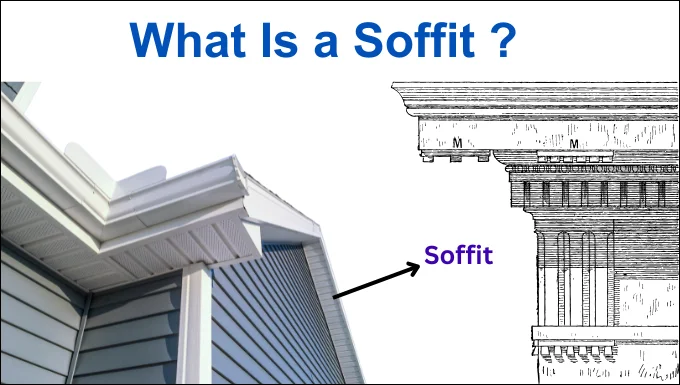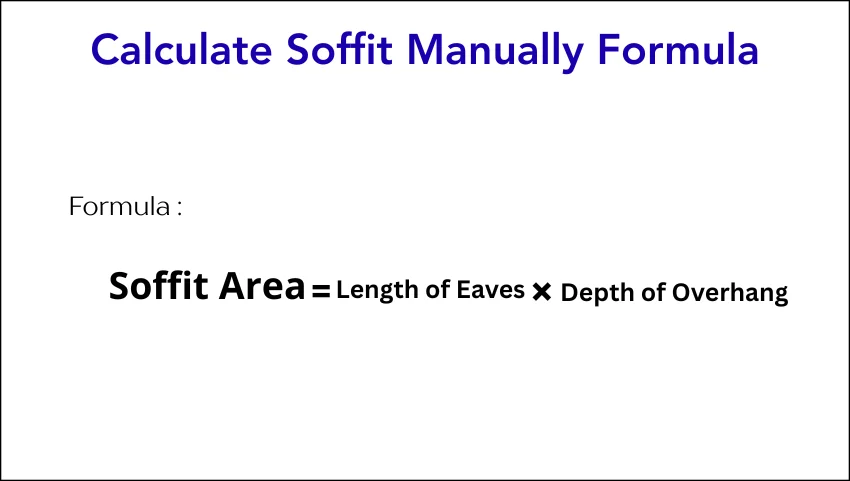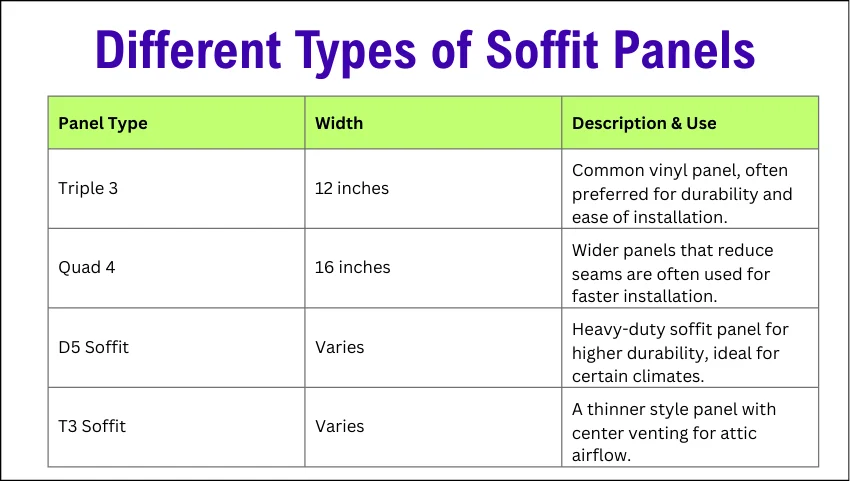Soffit Calculator
Calculate the exact amount of soffit materials you need for your project
How We Calculate
We split your fascia length into full 12-ft panel runs, split the overhang depth into full panel widths, then round up along both directions. This ensures you order whole pieces with zero shortage.
Trim counts (F/J and Double-channel) follow standard practice: 1× fascia + 1× wall, and one double-channel run per hip corner.
How to Use This Calculator
1. Measure the total length of all eaves that will receive soffit and enter the value in feet.
2. Measure the depth of the overhang from the wall to the fascia and enter the value in inches.
3. Choose the panel width you plan to install, either Triple 3 (12 in) or Quad 4 (16 in).
4. Count the hip corners on the roof, if any, and enter the number.
5. Select the ventilation style that matches the panel you intend to buy.
6. Read the results. Order the quantities shown for panels, F or J channel, and double channel.
When planning a roofing or home improvement project, one important element you might hear about is the soffit. A soffit is the material installed underneath the roof’s overhang, helping to protect your house while giving it a clean, finished look. If you are wondering how much soffit material you need for your project, this is exactly where a soffit calculator becomes useful.
What Is a Soffit ?
A soffit is the underside surface beneath the roof’s overhang or eaves. It’s what you see when you look up at the edge of your house roof, covering the gap between the roof and the exterior walls.

Functions of Soffits:
- Protection: Prevents moisture, pests, and debris from entering the roof space or attic.
- Ventilation: Helps air circulate in the attic to avoid heat buildup and moisture damage.
- Aesthetic Appeal: Gives your home a neat and polished exterior finish.
Soffits can be made from various materials, such as vinyl, aluminum, wood, or fiber cement, chosen based on durability and aesthetic preferences.
Visualizing soffits as the house’s “under-roof ceiling” can help understand their location and importance better.
Why Use a Soffit Calculator?
Calculating the amount of soffit material manually can be confusing, especially if you have multiple roof edges or varying overhang depths. A soffit calculator is an online or digital tool that takes your basic measurements and automatically calculates the exact amount of soffit panels and trim pieces needed for your project.
Benefits of Using a Soffit Calculator:
- Prevents Material Shortage: Ensures you order enough material without frequent supplier visits.
- Saves Money: Avoids over-purchasing, reducing wasted material and cost.
- Simplifies Planning: Gives you clear numbers to plan your budget and project timeline.
- Ventilation Calculation: Many soffit calculators also provide vent intake area to help balance attic airflow, promoting energy efficiency.
Understanding the Soffit Calculator Inputs
Before using a soffit calculator, you need these basic measurements:
1. Total Length of Eaves (Roof Edges)
This is the length along your house walls where you want to install soffit panels. It is usually measured in feet or meters. You’ll measure every roof edge that requires soffit.
2. Depth (or Width) of the Overhang
The depth tells you how far the roof overhangs from the house wall, measured from the exterior wall to the roof’s edge. This measurement is generally in inches or feet.
3. Soffit Panel Width
Different soffit panels come in various widths, such as
- Triple 3 (12 inches wide)
- Quad 4 (16 inches wide)
Choosing the right panel width ensures the calculator estimates correctly.
4. Number of Hip Corners (optional)
If your roof has hip corners (where two roof slopes meet), the calculator may ask for the number of these corners to calculate additional trim pieces.
5. Ventilation Type (if applicable)
Vented soffit panels help airflow in the attic and require different calculations. Some soffit calculators allow you to choose vented or solid panel types.
How to Calculate Soffit Manually (The Basic Formula)
If you want to understand how the calculator works, here is the simple formula used to calculate your soffit material needs: Soffit Area = Length of Eaves × Depth of Overhang

Where:
- Length of Eaves is the total length of all the roof edges where soffit is installed (in feet).
- Depth of overhang is how far the roof extends out from the wall (in feet).
Example:
Let’s say your house has:
- Length of eaves = 100 feet
- Overhang depth = 2 feet
Area of soffit to cover = 100×2=200100 \times 2 = 200100×2=200 square feet
If each soffit panel covers 12 square feet (1 ft wide by 12 ft long), you’ll need 12200≈16.7 panels
Since you can’t purchase a fraction of a panel, round up to 17 panels to ensure full coverage.
Step-by-Step Guide to Using a Soffit Calculator
Using a soffit calculator is straightforward. Here’s a simple step-by-step guide:
Step 1: Measure the Length of Your Roof Eaves
Use a tape measure to record the total length around your house where you plan to install soffit.
Step 2: Measure the Overhang Depth
Measure from the exterior wall straight out to the edge of the roof. Convert inches to feet if needed (e.g., 16 inches = 1.33 feet).
Step 3: Enter Measurements into the Calculator
Open a soffit calculator from a reliable source (e.g., Soffit Calculator) and enter:
- Eave length (feet)
- Overhang depth (inches or feet)
- Panel width (select from options)
- Number of hip corners
- Ventilation style (vented or solid)
Step 4: Review Calculation Results
The calculator will instantly show:
- Number of soffit panels needed
- Required trim pieces (like F or J channel)
- Ventilation net free area (NFA), if applicable
Step 5: Round Up and Order
Always round up panel and trim quantities to the nearest whole number to cover any cutting mistakes or complex fitting areas.
Different Types of Soffit Panels
You will encounter various soffit panel types like

| Panel Type | Width | Description & Use |
|---|---|---|
| Triple 3 | 12 inches | Common vinyl panel, often preferred for durability and ease of installation. |
| Quad 4 | 16 inches | Wider panels that reduce seams are often used for faster installation. |
| D5 Soffit | Varies | Heavy-duty soffit panel for higher durability, ideal for certain climates. |
| T3 Soffit | Varies | A thinner style panel with center venting for attic airflow. |
Choosing panel width and style impacts material quantity and ventilation considerations.
Why Soffit Ventilation Matters
Proper attic ventilation is critical for:
- Reducing Heat Buildup: Prevents the attic from becoming overheated in summer.
- Moisture Control: Stops condensation and mold growth by circulating air.
- Energy Efficiency: Good airflow helps reduce cooling costs.
Many soffit panels include vent holes to allow fresh air intake into the attic. The soffit calculator can estimate how much ventilation is provided based on panel type and quantity.
Common Mistakes to Avoid
When estimating soffit materials, watch out for these common errors:
- Not measuring accurately:Always double-check your tape measurements.
- Ignoring hip corners: Overlooking roof corners may lead to ordering insufficient trim.
- Using mixed units: Convert all measurements to a single unit system (feet or meters) before calculating.
- Underestimating waste: Always order a little extra for cuts and errors.
- Forgetting ventilation needs: Vented soffits require balancing airflow with other attic vents.
Additional Tips for Soffit Installation
- Hire a Professional if Unsure: If you have roof sections with complex angles or shapes, consulting a roofing expert ensures the right materials.
- Use Quality Materials: Invest in durable soffit materials that match your local weather conditions.
- Ensure Proper Ventilation: Pair soffit vents with ridge or gable vents for good attic airflow.
- Plan for Trim Pieces: Order additional F and J channel trims for neat panel edges and corners.
Frequently Asked Questions (FAQs)
Can I use the soffit calculator for commercial buildings?
Yes, you can use the calculator for larger or commercial buildings by measuring total soffit lengths for all sections. It is best to divide complex roofs into sections and add results.
How do I choose soffit panel width?
Choose based on availability and style preferences. Triple 3 (12-inch) panels are common, but wider panels like Quad 4 may reduce seams.
Does the calculator include ventilation calculations?
Most soffit calculators include ventilation net-free area estimation, which is essential for attic airflow balance.
What if my roof have different overhang widths?
Measure each section’s width separately and calculate material needs individually. Then sum totals for overall quantities.
Conclusion
A soffit calculator is an essential tool for anyone planning roofing or renovation projects involving soffits. It makes material estimation simple, accurate, and stress-free.
By inputting just a few measurements like eave length, overhang depth, and panel type, you can quickly find out exactly how many soffit panels and trims you need—saving time, money, and effort.
